Are you craving the rich, diverse flavors of Asian cuisine but don’t want to order takeout? With just a few ingredients and simple steps, you can enjoy delicious Asian recipes from the comfort of your own home. This collection of 30 recipes offers a variety of dishes, ensuring something for every palate.
From savory stir-fries to sumptuous stews, these recipes will guide you through creating authentic and mouth-watering meals. Embrace the opportunity to explore new flavors and cooking techniques, transforming ordinary nights into delightful culinary experiences.
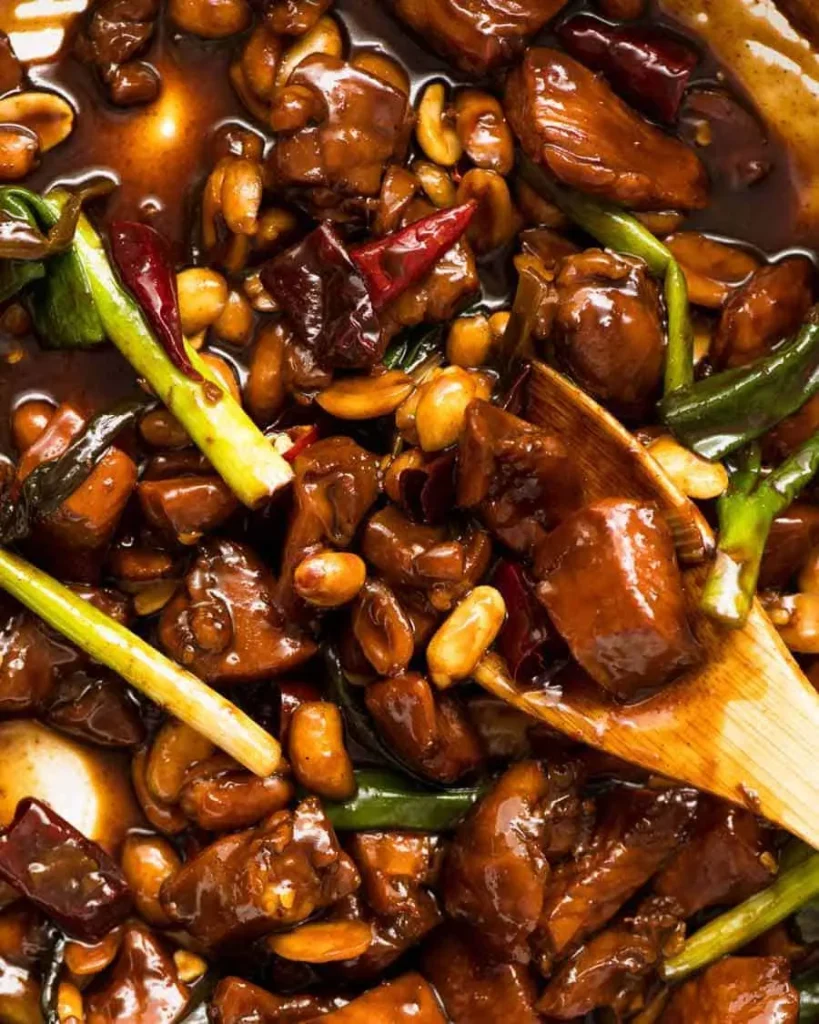
1) Kung Pao Chicken
Kung Pao Chicken is a popular Chinese dish known for its spicy and savory flavors. It typically features diced chicken, peanuts, and vegetables stir-fried in a slightly sweet, tangy sauce.
To start, you’ll need chicken cut into bite-sized cubes. Marinate the chicken with cornstarch, water, and a bit of sesame oil for tenderness.
Heat oil in a wok over high heat. Sear the chicken pieces until they’re golden brown. Remove the chicken and set it aside. Lower the heat and add more oil to the wok.
Next, add garlic, ginger, and dried chilies to the wok. These ingredients will provide the dish with its signature aroma and heat.
After cooking the aromatics for a minute, return the chicken to the wok. Add bell peppers and toasted peanuts for a nice crunch.
Prepare the sauce by combining light soy sauce, dark soy sauce, black rice vinegar, Shaoxing rice wine, sugar, cornstarch, and water. Pour the sauce into the wok and stir well to coat all the ingredients.
Cook until the sauce thickens and the chicken is fully cooked. Serve hot with steamed rice to enjoy the full burst of flavors.

2) Bibimbap
Bibimbap is a popular Korean dish that translates to “mixed rice with meat and assorted vegetables.” It’s well-known for its vibrant colors and balanced flavors. You can make it easily at home with a few basic ingredients.
Start by cooking a bowl of rice. Use short-grain white or brown rice for the best texture.
Prepare the vegetables. Common options include carrots, spinach, mushrooms, and zucchini. Slice them thinly and sauté each with a bit of oil until tender.
You can also add some protein. Beef is a traditional choice, but chicken, tofu, or a fried egg work well too. If using beef, marinate it with soy sauce, garlic, and sesame oil before cooking.
To assemble, place the rice in a bowl. Arrange the vegetables and protein on top in small piles. This keeps the colors and flavors distinct until you mix them.
Drizzle a bit of sesame oil and add a spoonful of gochujang, a spicy red pepper paste. The amount of gochujang can vary based on your spice preference.
Mix everything well before eating. The combination of flavors and textures makes bibimbap a delightful and satisfying meal.

3) Pho
Pho is a traditional Vietnamese noodle soup that is flavorful and aromatic. It’s made with beef bones, ginger, onions, and a mixture of spices like cinnamon, cardamom, coriander, and star anise.
You start by charring the ginger and onions to bring out their sweetness. Roast the beef bones until browned and then simmer them in water with the charred ginger and onions for several hours.
During the simmering process, add fish sauce and rock sugar to deepen the broth’s flavor. For the meat, use options like brisket or beef chuck, simmered until tender.
Once the broth is ready, strain it to remove bones and spices. Serve your Pho with rice noodles and a variety of toppings like fresh herbs, bean sprouts, lime wedges, and thin slices of beef.
You’ll love the burst of flavors and the comforting warmth of this iconic dish.

4) Sushi
Sushi is a beloved Japanese dish known around the world. It typically consists of seasoned rice combined with various ingredients like seafood, vegetables, and seaweed.
One of the most popular types of sushi is Nigiri. It features a slice of raw fish or other toppings placed on a small ball of rice. This simple combination highlights the freshness of the ingredients.
Makizushi, or sushi rolls, involves rolling sushi rice and fillings in nori seaweed. These rolls are then cut into bite-sized pieces. Common fillings include cucumber, avocado, and tuna.
Chirashi sushi offers a different experience. It translates to “scattered sushi” and involves a bowl of sushi rice topped with a variety of ingredients. This dish is like a deconstructed sushi roll.
Temaki, or hand rolls, are cone-shaped seaweed rolls filled with rice and other ingredients. They are easy to make and perfect for a casual sushi night at home.
Sushi isn’t just raw fish; there’s plenty of variety. Inari sushi comprises sushi rice stuffed into deep-fried tofu pouches, offering a sweet and savory option.
Temari sushi, small ball-shaped sushi, is another variant. These are often colorful and decorated, making them perfect for parties and special occasions.

5) Pad Thai
Pad Thai is a classic Thai dish that you can make at home. It’s made with rice noodles, a mix of proteins like shrimp, chicken, or tofu, and a flavorful sauce.
Start by cooking the noodles according to the package instructions, then rinse under cold water to stop them from cooking.
To make the sauce, mix fish sauce, soy sauce, brown sugar, rice vinegar, and a bit of Sriracha for some heat. Peanut butter can be added for extra richness, though it’s optional.
In a large pan, heat oil and sauté your protein choice with garlic. When the protein is almost cooked, push it to the side. Add more oil, if needed, and cook beaten eggs until they are just set.
With the eggs cooked, mix everything together, and add the noodles and sauce. Stir-fry to combine, ensuring the noodles are well-coated with the sauce. Add bean sprouts and chopped green onions for a fresh crunch.
Garnish with crushed peanuts and lime wedges before serving. The peanuts add texture, while the lime juice brings bright acidity to balance the flavors.

6) Dim Sum
Dim Sum is a traditional Chinese meal made up of small dishes. You usually enjoy it with hot tea, making it a popular brunch option. Each dish is meant to be shared, which makes it a great way to try a variety of flavors in one meal.
Some popular Dim Sum dishes include Shumai, which are dumplings filled with pork and mushrooms. These are typically steamed and served in bamboo baskets. Spring Rolls are another favorite, often stuffed with vegetables, and sometimes meat, then deep-fried until crispy.
Steamed Pork Buns, or Char Siu Bao, are yet another classic. These buns are filled with sweet and savory barbecue pork and steamed to perfection. Egg Tarts, known as Dan Tat, are a sweet end to your meal, with a flaky crust and creamy custard filling.
Turnip Cake, or Lo Bak Go, is another must-try. This dish is made from grated turnip mixed with rice flour and often includes bits of sausage, mushrooms, and shrimp. It’s usually steamed and then pan-fried to give it a crispy exterior.
Trying Dim Sum at home can be a fun cooking adventure. Many of the ingredients are common and can be found at most grocery stores. Enjoy the process and the delightful variety Dim Sum offers.

7) Samosas
Samosas are popular snacks enjoyed in many Asian countries. These tasty pastries are usually stuffed with a savory filling. They can be fried or baked.
The classic filling is a mix of potatoes, peas, and spices. You can start by heating oil and adding ginger, chili, cumin, and garam masala. Sautéing these spices releases their flavors.
For a twist, try fillings like cheese and corn, tandoori cauliflower, or mushroom and garlic. Each option brings a unique taste to this beloved snack.
When making samosas, shape the dough into triangles and fill them with your chosen ingredients. Seal them well to prevent any filling from spilling out.
Heat oil in a deep pan to fry the samosas until golden brown. Make sure to drain excess oil by placing them on a kitchen towel.
For a healthier option, bake the samosas at 200°F (95°C) until they are crispy.
Serve hot samosas with chutneys or sauces like sweet chili for added flavor.
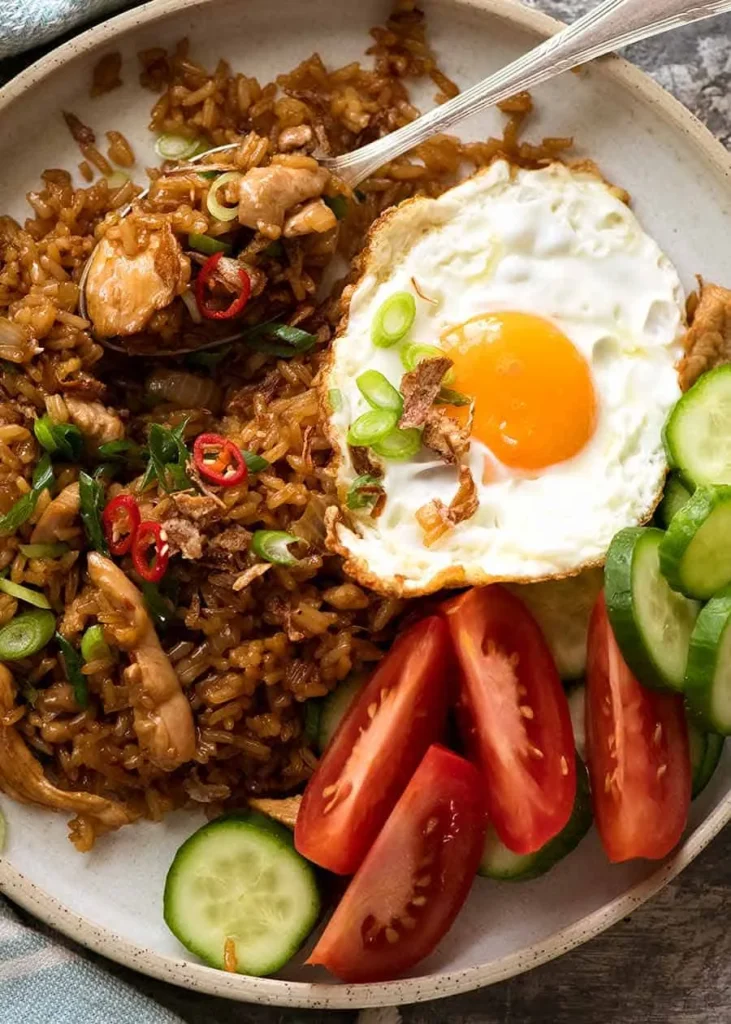
8) Nasi Goreng
Nasi Goreng, or Indonesian Fried Rice, is a popular and flavorful dish. It typically includes rice, chicken, and vegetables, all mixed with a sweet soy sauce called kecap manis.
Start by cooking garlic, shallots, and chili in a hot wok. These ingredients create a fragrant base.
Next, add chicken pieces and cook until they are no longer pink. Incorporate kecap manis and soy sauce, adding a rich, sweet flavor to the mix. It’s essential to keep stirring to ensure the chicken is evenly coated.
Add the pre-cooked rice to the wok, breaking up any clumps. The rice will soak up the flavors, turning a lovely brown color. For extra taste, some recipes suggest adding shrimp paste.
Fry an egg and set it aside. The egg is often placed on top of the rice when served. Adding sliced cucumbers, tomatoes, and fried shallots enhances the texture and presentation.
You might also want to include shrimp or prawn crackers on the side. If you enjoy spicy food, consider adding a tablespoon of chili sauce or chili oil.
Nasi Goreng is a versatile dish. You can customize it by adding your favorite vegetables or even tofu. Enjoy this delicious and easy-to-make dish at any time!

9) Ramen
Ramen is a rich and flavorful Japanese noodle soup that has become popular worldwide. You can make it at home with simple ingredients like broth, noodles, and your choice of toppings.
Start by heating some oil in a large pot. Add garlic and ginger, cooking until fragrant. Pour in chicken broth, soy sauce, and water. Bring this mixture to a boil, then reduce heat and let it simmer.
Once the broth is ready, cook your ramen noodles. Fresh or instant noodles both work well. Add them to the simmering broth and cook until tender.
Top your ramen with slices of chicken, pork, or tofu. You can also add vegetables like mushrooms, spinach, or corn. A soft-boiled egg and green onions make great finishing touches.
For extra flavor, consider adding a few dashes of hot sauce, red pepper flakes, or sesame oil. A squeeze of fresh lime juice can add a tangy twist.
Ramen is a versatile dish. You can adjust the ingredients and spices to suit your taste. The key to great ramen is a well-balanced broth and fresh toppings. Enjoy experimenting with different flavors and ingredients to create your perfect bowl of ramen.
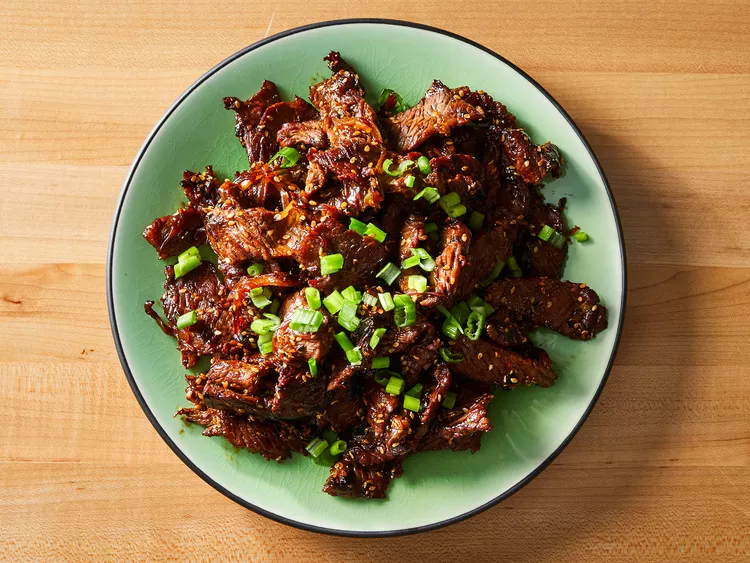
10) Bulgogi
Bulgogi is a popular Korean dish made with thinly sliced beef marinated in a sweet and savory sauce. It’s typically grilled or stir-fried, making it a versatile meal option.
To prepare bulgogi, start by freezing the beef for about 30 minutes. This makes it easier to slice thinly. Cut the steak into 1/4-inch thick slices against the grain.
For the marinade, mix soy sauce, brown sugar, sesame oil, garlic, and grated pear. The pear adds a natural sweetness and helps tenderize the meat.
Combine the beef and marinade in a large bowl or Ziploc bag. Let it marinate in the refrigerator for at least two hours, but it can be left overnight for more flavor.
When you’re ready to cook, heat a skillet or grill over medium-high heat. Add a bit of cooking oil and cook the beef slices until they are browned and slightly caramelized.
Serve bulgogi with steamed rice and a variety of side dishes, such as kimchi, pickled radish, and fresh lettuce leaves. You can also add sesame seeds and sliced green onions for extra flavor.
Bulgogi is delicious and perfect for BBQs or family dinners. It’s a great way to introduce Korean cuisine to friends and family.

11) Sweet and Sour Pork
Sweet and Sour Pork is a classic Asian dish that balances both tangy and sweet flavors. It’s widely loved for its vibrant colors and delightful taste.
Start by cutting pork into bite-sized pieces. Marinate the pork with your choice of seasoning. This could include soy sauce, garlic, and a hint of ginger.
Next, prepare the coating. Use cornstarch to coat the pork pieces. This will make them crispy when fried. Coat the pork twice for extra crispiness.
Heat oil in a pan and fry the pork until it turns golden brown. Remove the pork and set it aside.
In the same pan, heat some sesame oil. Add sliced bell peppers and onions. Cook them until they are slightly tender.
Now, it’s time for the sauce. Mix tomato paste, white vinegar, sugar, and soy sauce in a small pan. Let it simmer for a few minutes until it thickens.
Combine the fried pork with the cooked vegetables. Pour the sauce over the mixture and stir well. Ensure every piece is well-coated with the sauce.
Serve your Sweet and Sour Pork hot, preferably with steamed rice. It’s a quick and easy recipe that brings bold flavors to your table.
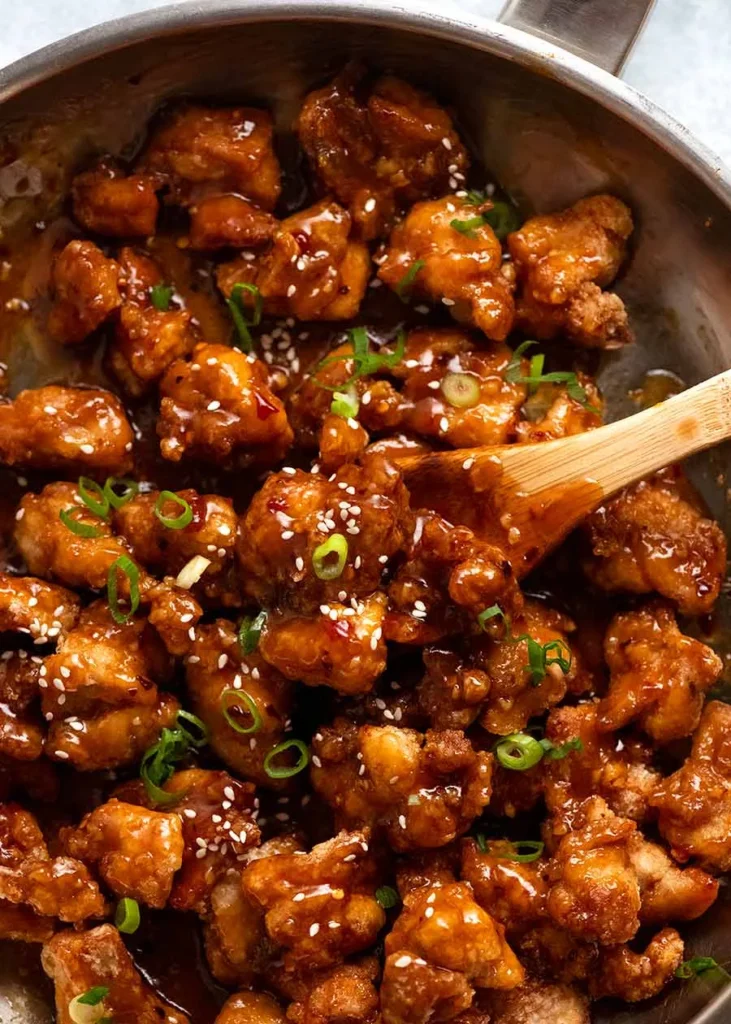
12) General Tso’s Chicken
General Tso’s Chicken is a popular Chinese-American dish. It features crispy fried chicken tossed in a sweet and spicy sauce.
To make it, start by cutting chicken into bite-sized pieces. Toss the pieces in cornstarch or a mix of cornstarch and flour. Fry these pieces until golden and crispy.
Prepare the sauce using soy sauce, vinegar, sugar, and some chicken broth. Add garlic, ginger, and dried chilies for extra flavor. Cook the sauce until it thickens and becomes glossy.
Add the fried chicken to the sauce and mix well. Serve it hot with steamed white rice or vegetables. This dish is known for its bold flavors and satisfying crunch.

13) Teriyaki Salmon
Teriyaki salmon is a delicious and simple dish that combines savory and sweet flavors. Start by marinating your salmon fillets in a mix of soy sauce, brown sugar, and mirin or rice wine vinegar. Let the fish soak up these flavors for about 20 to 30 minutes.
Once marinated, heat some oil in a pan over medium heat. Place the salmon skin-side down first. Cook for around 3 to 6 minutes until the skin becomes crispy. Flip the salmon and cook the other side until it’s no longer pink in the center.
For an extra layer of taste, you can add garlic, ginger, or even a splash of sake into the marinade. If you prefer a thicker sauce, simmer the marinade in a saucepan until it reduces to a glaze. Drizzle this over the cooked salmon before serving.
Serve your teriyaki salmon with steamed rice and a side of vegetables. This well-loved dish is quick to prepare and brings bold, delightful flavors to your table. Whether for a weeknight dinner or a special occasion, teriyaki salmon is sure to impress.

14) Tom Yum Soup
Tom Yum Soup is a flavorful Thai soup known for its tangy and spicy taste. It is often made with shrimp, also called Tom Yum Goong.
Start by preparing the broth. Traditional recipes use shrimp heads and shells, which are stir-fried and then simmered in water to create a rich stock. If you prefer, you can use shrimp paste.
Add lemongrass, kaffir lime leaves, and galangal to the broth. These ingredients give the soup its signature fragrant aroma. Let these spices simmer for about 15 minutes to infuse the broth with flavor.
Next, add mushrooms to the broth and let them cook for a couple of minutes. Mushrooms give a nice texture and flavor to the soup.
Finally, add the shrimp. Let the soup simmer until the shrimp are just cooked through. The heat of the soup will continue to cook the shrimp even after you turn off the heat.
Tom Yum Soup is typically served with rice and can be enjoyed as a part of a larger meal with other Thai dishes. Its salty and sour flavors make it a standout dish in Asian cuisine.

15) Satay Chicken
Satay Chicken is a famous dish that hails from Southeast Asia. It’s known for its flavorful marinade and delicious peanut sauce. To make it, you’ll need chicken pieces, skewers, and a few key ingredients for the marinade and sauce.
Start by preparing the marinade. Common ingredients include coconut milk, soy sauce, curry powder, turmeric, garlic, and brown sugar. Mix these together in a bowl. Then, combine the chicken with the marinade and let it sit in the fridge for a few hours, or better yet, overnight.
While the chicken is marinating, you can make the peanut sauce. This usually consists of peanut butter, coconut milk, soy sauce, lime juice, and a bit of garlic and ginger. Heat these ingredients together in a saucepan until the sauce is smooth and slightly thick.
When you’re ready to cook the chicken, thread the pieces onto bamboo skewers. Grill or broil them until they’re cooked through and have a nice char on the outside. Serve the skewers with the peanut sauce on the side for dipping.
Satay Chicken makes for a great appetizer or main dish. The combination of the savory chicken and the sweet-salty peanut sauce is hard to resist. Try it for your next meal and enjoy the flavors of Southeast Asia.

16) Bao Buns
Bao Buns, also known as baozi, are soft, fluffy, and slightly sweet steamed buns that can be filled with a variety of ingredients, such as pork, chicken, or vegetables.
To make Bao Buns, start by mixing warm water, milk, active yeast, and sugar. Let the mixture sit for about 10 minutes until the yeast is activated and bubbly.
Next, combine flour, sugar, baking powder, and a pinch of salt in a mixing bowl. Gradually add the yeast mixture while stirring, forming a rough dough. Knead the dough until smooth, either by hand or using a stand mixer.
Cover the dough and let it rise in a warm place for about 60 to 90 minutes. It should double in size. Once risen, knead the dough again to release any air bubbles.
Roll out the dough and cut it into small, equal-sized pieces. Flatten each piece and fold it in half. Allow the shaped buns to rest for a bit before steaming.
Steam the Bao Buns over medium heat for about 10 minutes until they are puffy and cooked through. Serve warm with your favorite fillings.
Making Bao Buns may seem time-consuming, but the soft, pillowy results are worth it. These buns are perfect for parties, dinners, or simply as a delightful snack.

17) Tandoori Chicken
Tandoori Chicken is a popular dish from India. It’s known for its smoky flavor and vibrant red color. You achieve this by marinating chicken in a mixture of yogurt and spices.
Start with skinless chicken pieces. Use Greek yogurt as the base for the marinade. Add garlic, ginger, mustard, and red chili powder. You can use Kashmiri chili powder for a deep red color.
Mix all the ingredients well. Coat the chicken pieces in this marinade. Let the chicken marinate for at least 2 hours. For the best results, marinate for up to 24 hours in the fridge.
For cooking, you can use an oven or grill. Preheat your oven to 400°F (207°C). Arrange the marinated chicken on a baking sheet lined with aluminum foil. Roast for about 15 minutes.
Alternatively, you can grill the chicken. Heat the grill and cook the chicken until it’s done. The chicken should have a nice char and smoky flavor.
Serve your Tandoori Chicken hot. It pairs well with Indian-style rice or naan bread. Enjoy the rich, aromatic taste with every bite.

18) Laksa
Laksa is a flavorful noodle soup with roots in Southeast Asia, especially Malaysia and Singapore. It combines spicy, sweet, and savory flavors in a rich coconut milk broth.
You start by heating oil in a pot over medium heat. Add minced garlic, ginger, lemongrass, and chilies. Sauté for a few minutes until fragrant.
Next, stir in laksa paste. Cook, while stirring, until the paste becomes aromatic.
Pour in chicken stock, coconut milk, and fish sauce. Bring the mixture to a simmer, allowing the flavors to meld.
You can add cooked chicken, shrimp, or tofu for protein. Let the ingredients simmer until they are fully cooked and tender.
To serve, place cooked rice noodles in a bowl. Ladle the hot broth over the noodles, ensuring you get some protein and herbs in each serving.
Top your laksa with bean sprouts, boiled eggs, fresh cilantro, and lime wedges.
Enjoy a bowl of laksa for a taste of Southeast Asia in your own kitchen.
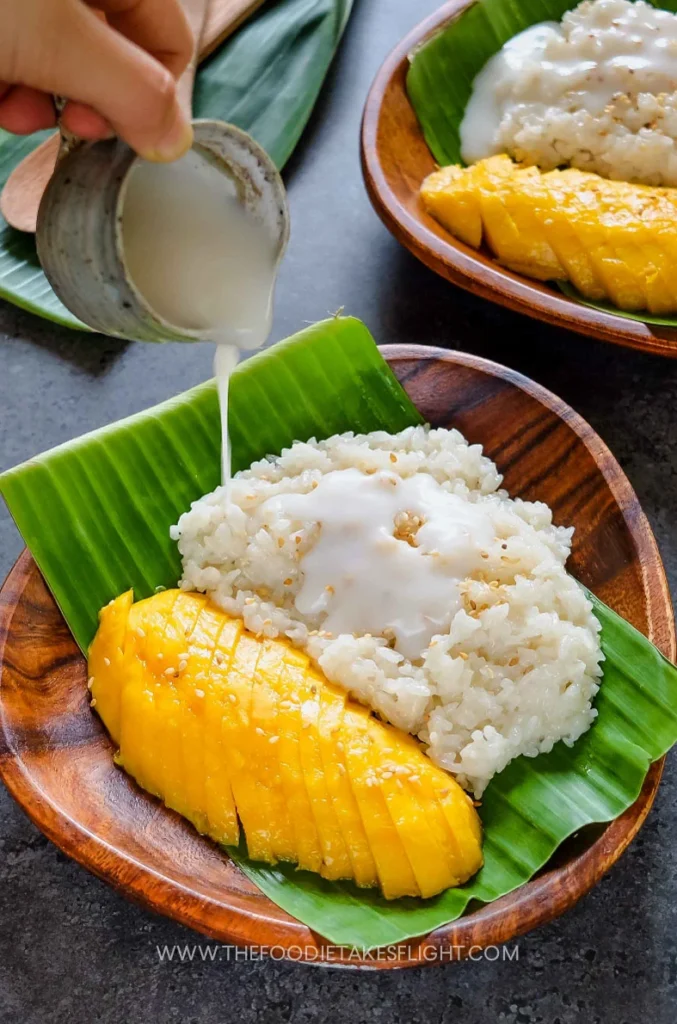
19) Mango Sticky Rice
Mango Sticky Rice is a popular Thai dessert that combines sweet mangoes with sticky rice and coconut milk. This dish is famous for its delightful contrast of flavors and textures.
To start, steam the sticky rice for about 15-20 minutes until fully cooked. Use a steamer basket for the best results.
While the rice is steaming, heat coconut cream in a pot on medium heat. Add sugar and a pinch of salt, stirring occasionally until everything dissolves.
Once the rice is cooked, transfer it to a large bowl and pour the sweetened coconut cream over it. Mix well and let it sit for a few minutes to absorb the flavors.
Cut the ripe mangoes into slices or cubes. Serve the sticky rice with fresh mango on the side. Drizzle any remaining coconut cream over the top for extra flavor.
Enjoy this delicious treat warm or at room temperature. The combination of sweet, juicy mango and creamy, sticky rice is sure to be a hit with everyone.

20) Tempura
Tempura is a popular Japanese dish that features seafood or vegetables dipped in a light, airy batter and deep-fried to golden perfection.
To make tempura, you need a simple batter. Typically, this batter consists of flour, ice-cold water, and a beaten egg. Using cold water helps prevent gluten formation, ensuring a crispy texture.
Heat your oil to around 350°F (175°C). For best results, use a deep fryer or a heavy-bottomed pan. Dip your chosen ingredients, such as shrimp, sweet potatoes, or kabocha squash, into the batter.
Carefully place the battered food into the hot oil. Fry each piece until it turns golden brown. This usually takes about 2-3 minutes for most ingredients. Make sure not to overcrowd the pan, as it can lower the oil temperature.
Once cooked, transfer the tempura to a wire rack or plate lined with paper towels. This helps drain excess oil and keeps the tempura crispy. Serve immediately with a dipping sauce, such as tentsuyu, for the best experience.

21) Banh Mi
Banh Mi is a popular Vietnamese sandwich that combines French and Vietnamese culinary traditions. It’s typically made with a light, crispy baguette.
For the filling, you can use various proteins like pork, tofu, or cold cuts. Marinate the protein with flavorful ingredients such as garlic, soy sauce, and lime juice.
Spread mayonnaise or butter on the baguette. Add a layer of liver pâté for a rich flavor. Place the marinated protein on top.
Next, include fresh vegetables like cucumbers and cilantro. Pickled daikon and carrots add a nice tangy crunch.
Season with chili slices if you like some heat. Banh Mi is a delicious, versatile sandwich that you can easily customize.

22) Kimchi
Kimchi is a staple in Korean cuisine. It’s a traditional side dish of fermented vegetables, usually made from Napa cabbage and Korean radishes.
First, you need to prepare the cabbage. Cut it into quarters, remove the tough cores, and sprinkle with salt. Let it sit for about 30 minutes to draw out moisture.
While the cabbage sits, you can make the kimchi paste. In a bowl, mix together minced garlic, ginger, sugar, fish sauce, and Korean chili flakes. This mixture adds the spicy, tangy flavor kimchi is known for.
After the cabbage has softened, rinse it with water to remove the excess salt. Then, spread the kimchi paste evenly over each leaf. Make sure to coat well for consistent flavor.
Once coated, place the cabbage in a container. Press down to remove air pockets. Leave it at room temperature for a day or two to start the fermentation. Afterward, transfer it to the refrigerator.
Kimchi can be enjoyed on its own or as an ingredient in other dishes like stews and pancakes. It’s known for its distinctive taste and health benefits, thanks to the fermentation process.

23) Spring Rolls
Spring rolls are a popular dish in many Asian cuisines. You can find variations from China, Vietnam, and Thailand. They can be deep-fried or fresh, depending on your preference.
Traditional Chinese spring rolls are filled with ingredients like pork, shrimp, napa cabbage, and mushrooms. You stir-fry the filling and then wrap it in a thin pastry. Deep-fry until golden and crispy.
Fresh spring rolls, often seen in Vietnamese cuisine, use rice paper wrappers. You soak the wrappers in water briefly to make them pliable. Fill them with noodles, shrimp, lettuce, and herbs. These rolls are not fried, giving them a fresh, light taste.
You can also make spring rolls in an air fryer for a healthier option. Brush the rolls with a little oil and cook them until crispy. They might not be as crunchy as deep-fried ones, but they are still delicious.
Spring rolls are versatile and can be filled with a variety of ingredients. You can add tofu, different vegetables, or even fruits. They are perfect as an appetizer or as part of a main course.

24) Gyoza
Gyoza are Japanese dumplings filled with ground meat and vegetables. They are pan-fried, giving them a crispy bottom and juicy interior. You can find them at most Japanese restaurants, but they’re also easy to make at home.
Start by preparing the filling. Combine ground pork, finely chopped cabbage, green onions, minced garlic, and ginger in a bowl. Add seasonings like soy sauce, sesame oil, and sake. Mix everything well.
The wrappers are usually round and made from wheat flour. Place a small spoonful of filling in the center of each wrapper. Fold them in half and pleat the edges to seal.
Heat oil in a skillet over medium-high heat. Arrange the gyoza in the skillet with the pleated edge up. Cook for about 2-3 minutes until the bottoms are golden.
Add a tablespoon of water to the pan and quickly cover it with a lid. This steams the gyoza and finishes cooking them. After about 3 minutes, uncover the pan and let the remaining water evaporate.
Serve the gyoza hot, with dipping sauce on the side. A simple sauce can be made using soy sauce, rice vinegar, and a dash of chili oil. Enjoy your homemade gyoza as an appetizer or main dish.

25) Green Curry
Green Curry is a flavorful and aromatic dish from Thailand. It’s known for its vibrant color and rich taste.
You start by heating oil in a pot and sautéing shallots until soft. Then add green curry paste and stir for a few minutes until it smells amazing.
Next, add chicken broth or stock. This helps to deglaze the pot and pick up all the flavors. Be sure to keep stirring.
Pour in coconut milk to give the curry its creamy texture. Some recipes suggest blending coconut milk with fresh basil for an extra burst of flavor and color.
You can add chicken pieces, cooked until they are brown, and your favorite veggies. Common choices are bell peppers, zucchini, and green beans.
Season with fish sauce and sugar to balance the flavors. Kaffir lime leaves are a great addition if you have them on hand.
Simmer everything together until the chicken is tender and the vegetables are cooked through.
Serve your Green Curry over steamed rice for a satisfying meal. The combination of spicy, sweet, and savory will surely impress.
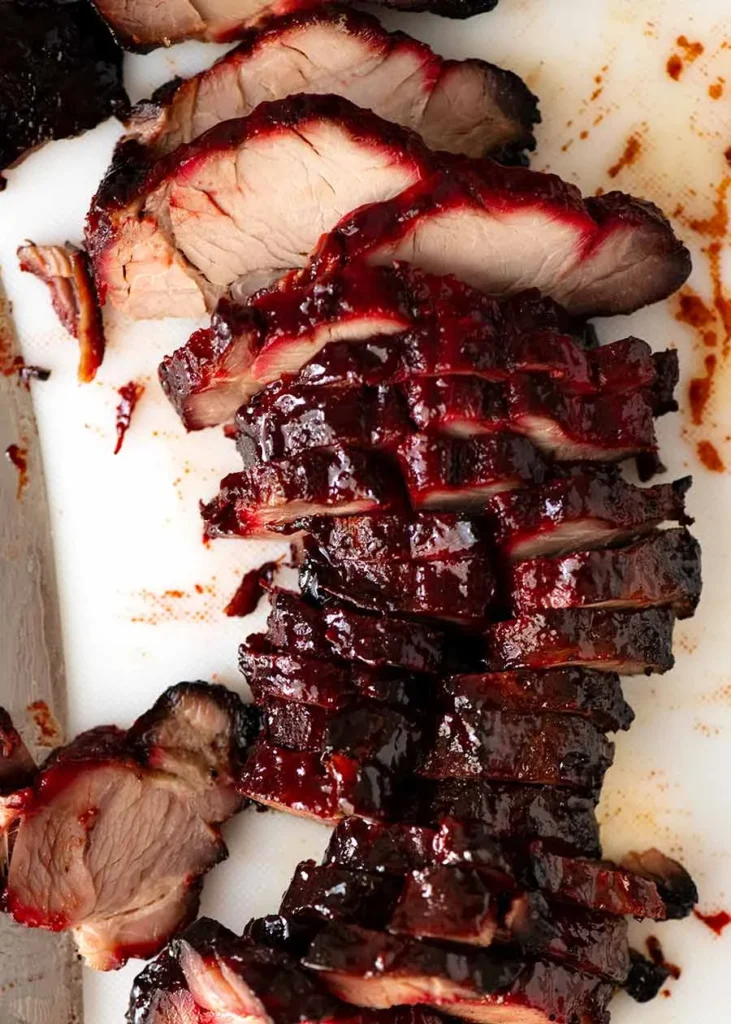
26) Char Siu
Char Siu is Chinese BBQ pork that is marinated and roasted to perfection. It’s known for its sweet, savory, and slightly smoky flavor. The marinade typically includes ingredients like soy sauce, hoisin sauce, five-spice powder, and honey.
To make Char Siu, marinate the pork in the sauce for at least four hours, preferably overnight. This helps the meat absorb all the flavors. Preheat your oven to about 375°F.
Place the marinated pork on a rack over a baking tray. Roast the pork in the oven, basting it with the marinade every 20 minutes. This will create a caramelized, sticky glaze on the pork. The meat should be cooked until tender and slightly charred but not falling apart.
Once done, let the pork rest, then slice it into thin pieces. Serve it with steamed rice or noodles for a delicious meal.

27) Hainanese Chicken Rice
Hainanese Chicken Rice is a popular dish in Southeast Asia, especially in Singapore and Malaysia.
You’ll start by poaching a whole chicken in water until it’s tender. Save the broth for cooking the rice and making a soup on the side.
For the rice, use jasmine rice. Fry some chopped garlic and ginger in a bit of oil. Add the rice and fry it until it’s fragrant.
Pour in the reserved broth and cook the rice until it’s tender. This rice is full of flavor from the broth and the aromatics.
Make a chili sauce for dipping. Blend red chili, garlic, ginger, salt, sugar, and a bit of lime juice until smooth. You can also add a bit of chicken broth to dilute it.
Serve the sliced chicken on top of the fragrant rice with a side of chili sauce and some soup made from the broth. Garnish with cucumber slices and fresh cilantro for extra freshness.
Hainanese Chicken Rice may seem simple, but it’s a flavorful and comforting dish that many love.

28) Pepper Beef
Pepper Beef is a popular stir-fry dish that combines tender beef slices with colorful bell peppers and a savory sauce. This dish is both quick to make and full of flavor. You can use either a wok or a large skillet for cooking.
Start by marinating thin slices of beef in a mixture of soy sauce, garlic, and ginger. Let it sit for at least 15 minutes to absorb the flavors.
Heat some oil in your cooking pan over medium-high heat. Add the beef slices in batches and sear them on each side for about 30 seconds. Remove the beef and set it aside.
In the same pan, add sliced bell peppers and cook for a minute. Pour a splash of Shaoxing wine or broth to deglaze the pan. This will lift all the flavorful bits stuck to the bottom.
Return the beef to the pan, mixing it with the peppers. Pour in a sauce made from soy sauce, oyster sauce, and a bit of sugar. Stir everything together until the beef is well-coated and the sauce thickens slightly.
Serve your Pepper Beef hot with steamed rice or noodles. This dish is perfect for a quick, tasty meal any night of the week.

29) Crispy Peking Duck
Crispy Peking Duck is a popular Chinese dish known for its flavorful, crispy skin and juicy meat. Prepare the duck by seasoning it inside and out. A mixture of salt, five-spice powder, and pepper works well. Rub this mix inside the cavity for a well-seasoned bird.
Preheat your oven to around 425°F if using a conventional oven. Place the duck breast side up on a roasting rack in a roasting pan. This allows the fat to drip and prevents the duck from becoming greasy.
Roast the duck initially at high heat for about 15 minutes. Reduce the oven temperature afterward and continue roasting until the skin turns golden brown and crispy.
After roasting, let the duck rest for a few minutes. This helps the juices redistribute within the meat. Carve the duck into thin slices, starting with the crispy skin. Serve with Mandarin pancakes, hoisin sauce, and sliced green onions.
For additional crispiness, you can broil the duck briefly on low heat. Keep an eye on it to prevent burning. This extra step makes the skin extra crispy.

30) Matcha Cheesecake
Matcha cheesecake combines the rich, creamy texture of traditional cheesecake with the unique flavor of Japanese green tea.
To start, preheat your oven to 200°C (392°F) for a consistent baking temperature.
You’ll need cream cheese, sugar, eggs, and matcha powder. Soften the cream cheese and mix it with sugar until smooth. Add the eggs one at a time, blending well after each addition.
For a smoother texture, make sure your cream cheese, eggs, and heavy cream are at room temperature before mixing.
Pour the batter into a cake pan. You can bake it directly or use a water bath for a more even bake. If using a water bath, fill a larger tray with about 2cm of hot water and place your cake pan inside.
Bake at 200°C for about 50-60 minutes, or until the top is golden brown.
The earthy flavor of matcha balances perfectly with the sweetness and richness of the cheesecake. Enjoy!
Essential Ingredients in Asian Cuisine
Asian cuisine is rich in variety and relies on specific ingredients that give each dish its unique flavor. Knowing the essential spices, herbs, staple, and regional ingredients will help you master these recipes.
Common Spices and Herbs
Spices and herbs are vital in Asian cooking. Ginger is often grated or minced to add a fresh, spicy flavor to dishes. Garlic is another staple, used to enhance the aroma and taste of many recipes. Cilantro is common in Southeast Asian dishes, providing a fresh, citrusy touch. Five spice powder, a mix of star anise, clove, cinnamon, fennel seed, and Sichuan peppercorn, is used in Chinese recipes for its warm, savory notes. Turmeric, widely used in Indian cuisine, adds flavor and a vibrant yellow color to dishes.
Staple Ingredients
Staple ingredients are foundational in Asian cooking. Rice is a primary food source, often served alongside main dishes. Noodles, like rice noodles and glass noodles, are used in soups, stir-fries, and spring rolls. Soy sauce adds saltiness and depth to various recipes. Fish sauce is essential in Thai and Vietnamese cooking for its strong umami flavor. Coconut milk, used mainly in Southeast Asian and Indian cuisines, adds a rich, creamy texture. Tofu, a versatile protein, is used in stir-fries, soups, and even desserts.
Regional Ingredients
Different regions have unique ingredients that define their cuisine. Limes are crucial in Thai and Vietnamese dishes for their tangy flavor. Kaffir lime leaves and lemongrass are key in Thai curries and soups. Shiitake mushrooms, both fresh and dried, are popular in Japanese cooking, adding depth to soups and stews. Miso paste, made from fermented soybeans, is a staple in Japanese kitchens. Cooking wines, like Shaoxing wine in Chinese cuisine, enhance the flavor profile of many dishes. Gochujang, a Korean fermented chili paste, is used to add spice and complexity to dishes.
Key Cooking Techniques in Asian Recipes
Asian cuisine uses various cooking techniques to create its diverse and flavorful dishes. Some of the most important techniques include stir-frying, steaming, grilling and barbecuing, and fermentation.
Stir-frying
Stir-frying is quick and done over high heat. You use a wok or a large pan. Ingredients are cut into small, uniform pieces. This technique preserves the texture and color of the ingredients. The cooking process is fast, usually taking just a few minutes.
To achieve the best results, ensure your wok or pan is very hot before adding oil. Important tip: Use oils with high smoke points, like peanut or vegetable oil. Add ingredients in batches, starting with ones that take longer to cook, like meat, followed by quicker-cooking vegetables.
Steaming
Steaming preserves nutrients and the natural flavors of food. It’s common in many Asian dishes. Types of steaming: bamboo steamers, metal steamers, or wrapped in leaves. This method is ideal for fish, dumplings, and vegetables.
To steam, place food on a steamer rack above boiling water. Ensure there’s enough space for steam to circulate. Pro tip: Adding aromatics like ginger or garlic to the water can infuse more flavor into your food. Keep the lid on to maintain steam and heat.
Grilling and Barbecuing
Grilling and barbecuing impart a smoky flavor to meats and vegetables. This technique is popular in Asian cuisines like Korean and Japanese. Foods are often marinated to enhance flavor.
Use direct or indirect heat depending on the food type. Direct heat is good for quick cooking, while indirect heat is better for larger cuts of meat. Grilling tips: Soak wooden skewers to prevent burning and turn food frequently to ensure even cooking. Korean cuisine, for example, uses grills built into tables, while Japanese yakitori uses small portable grills.
Fermentation
Fermentation develops complex flavors and preserves food. It is crucial in making dishes like kimchi, miso, and soy sauce. This process involves beneficial bacteria converting sugars into acids or alcohol.
Key steps: Cleanliness is vital to prevent contamination. Use clean jars and utensils. The right temperature and time are important. For example, kimchi ferments at room temperature for a few days before refrigeration. Fermented foods can offer health benefits due to probiotics.
Remember, fermentation can take days to months, but the deep flavors and preservation benefits are worth the wait. Always store fermented foods in proper conditions to maintain their quality and safety.
Health Benefits of Asian Cuisine
Asian cuisine, known for its rich flavors and diverse ingredients, offers various health benefits. It highlights nutrient-rich components and strives for a balance of flavors, while also catering to various dietary needs.
Nutrient-rich Ingredients
Many Asian dishes use fresh vegetables, lean proteins, and hearty grains. Ingredients such as tofu, seaweed, and mushrooms contribute essential vitamins and minerals. Soy-based products are common and provide a good source of protein and healthy fats.
Asian food frequently incorporates spices and herbs like ginger, garlic, and turmeric, which have anti-inflammatory properties. These ingredients can enhance your immune system and promote overall health. Green tea, widely consumed in many Asian countries, is rich in antioxidants, known to support heart health and reduce risks of certain cancers.
Moreover, the use of broths and soups made from bones and vegetables often results in nutrient-dense meals that are easy to digest and beneficial for gut health.
Balance of Flavors
Asian cuisine masters the harmony of sweet, sour, salty, bitter, and umami tastes. This balance is not only pleasing to the palate but can also help regulate appetite and portion control. For instance, dishes like Tom Yum soup combine spicy, sour, sweet, and salty flavors, offering a unique culinary experience.
The variety of flavors also encourages eating a wide range of foods, resulting in a more diverse intake of nutrients. Additionally, using natural flavor enhanceants like soy sauce, fish sauce, and rice vinegar can reduce the need for added sugars and unhealthy fats.
Such balanced meals can lead to more satisfying eating experiences, aiding in better digestion and nutrient absorption.
Dietary Considerations
Asian cuisine is versatile and can suit various dietary preferences and restrictions. Many dishes are naturally gluten-free, such as rice-based meals and noodle dishes made from rice or sweet potato. Vietnamese pho and Japanese sushi are good examples of gluten-free options.
Furthermore, lots of Asian recipes are easily adaptable for vegetarian and vegan diets. Dishes like sesame noodles with vegetables and vegetable stir-fry offer delicious plant-based options.
Additionally, low-carb choices are abundant, such as dishes focusing on protein and vegetables rather than grains. This makes it suitable for those on keto or other low-carb diets, ensuring a nutritious yet enjoyable dining experience for all dietary requirements.








